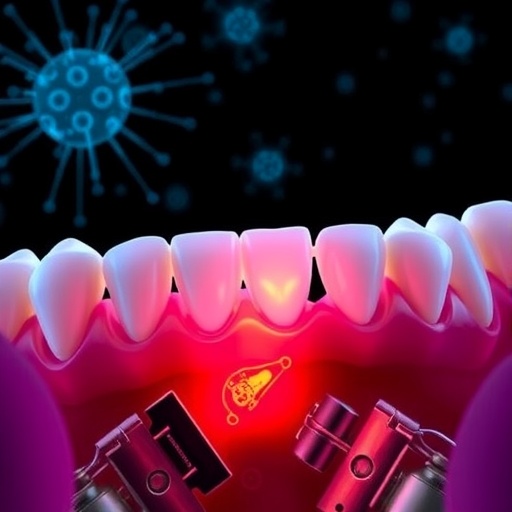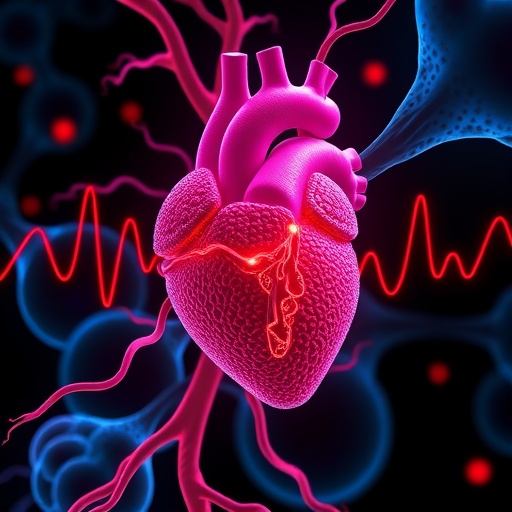In the intricate landscape of oral health, apical periodontitis (AP) stands as a prominent inflammatory disease characterized by the destruction of periapical tissues. Recent advances in cellular biology are unraveling the complex role of regulated cell death (RCD) in the pathogenesis and potential treatment of this pervasive condition. Scientists are increasingly recognizing that multiple modalities of RCD not only contribute to tissue damage but might also be strategically harnessed to curb the progression of infection and inflammation in AP, revealing a dualistic and finely balanced biological phenomenon.
At its core, regulated cell death encompasses a spectrum of controlled cellular demise pathways, including apoptosis, necroptosis, pyroptosis, and ferroptosis, which are integral in maintaining tissue homeostasis and modulating immune responses. In the context of AP, these cell death pathways are triggered by oral bacterial pathogens invading the periapical tissues, where they set off a cascade of inflammatory and immunological events. This dynamic interplay between microbe-induced RCD and host defense mechanisms shapes not only disease progression but potentially its resolution.
One of the central challenges in understanding AP lies in the cellular heterogeneity within the periapical zone. Different cell populations—ranging from immune cells like macrophages and neutrophils to resident cells such as fibroblasts and osteoblasts—exhibit distinct sensitivities and responses to pathogenic insults. Virulent bacterial species implicated in AP have been shown to selectively induce specific RCD modalities within these diverse cell subsets, thereby orchestrating a tailored yet complex network of host-pathogen interactions.
.adsslot_Ti2SkNAHlq{width:728px !important;height:90px !important;}
@media(max-width:1199px){ .adsslot_Ti2SkNAHlq{width:468px !important;height:60px !important;}
}
@media(max-width:767px){ .adsslot_Ti2SkNAHlq{width:320px !important;height:50px !important;}
}
ADVERTISEMENT
Recent experimental evidence highlights pyroptosis, a pro-inflammatory form of cell death driven by inflammasome activation, as a key mediator in the early stages of AP. The lytic nature of pyroptosis releases danger-associated molecular patterns (DAMPs) and cytokines, amplifying local inflammation and recruiting additional immune effectors. While this initially aids in pathogen clearance, excessive or prolonged pyroptosis may exacerbate tissue destruction, underscoring the double-edged sword nature of RCD in oral inflammation.
Similarly, necroptosis, a form of programmed necrosis governed by receptor-interacting protein kinases, has emerged as another pivotal pathway in AP pathophysiology. Unlike apoptosis, necroptosis culminates in cell rupture and inflammatory mediator release, contributing to the chronicity and severity of periapical lesions. Targeting necroptotic signaling pathways thus represents a promising therapeutic avenue to restrain deleterious inflammation without compromising host antimicrobial defenses.
Apoptosis, traditionally viewed as a silent and non-inflammatory mode of cell death, paradoxically assumes both protective and destructive roles in AP. The controlled removal of infected or damaged cells through apoptosis helps maintain tissue integrity and limits pathogen persistence. However, the dysregulation or inhibition of apoptosis can lead to sustained infection and heightened immune activation, revealing its crucial role in fine-tuning the balance between host protection and pathological inflammation.
Emerging research also underscores the involvement of ferroptosis, an iron-dependent form of cell death characterized by lipid peroxidation, in AP. Given the oxidative stress prevalent in inflamed periodontal tissues, ferroptotic processes may contribute to both microbial control and collateral tissue damage. Investigating the molecular triggers and regulators of ferroptosis in periapical cells could open new frontiers for antioxidant-based therapeutic interventions.
The spatial and temporal orchestration of these RCD pathways is further complicated by the diverse microbial communities inhabiting the root canal environment. Polymicrobial infections characteristic of AP employ sophisticated virulence factors to manipulate host cell death machinery, evading immune clearance while simultaneously promoting inflammatory damage that benefits their persistence and dissemination. Decoding these pathogen-directed RCD mechanisms is critical to developing precise and effective therapeutic strategies.
Intriguingly, the dual functions of RCD extend beyond mere destruction. Controlled induction of specific cell death pathways can enhance antigen presentation and adaptive immunity, potentially enabling the immune system to better recognize and eliminate entrenched pathogens. This suggests that therapeutic modulation, rather than wholesale inhibition of RCD, could transform AP management by tipping the balance toward resolution and regeneration.
Interdisciplinary research combining immunology, microbiology, and cell biology is now focusing on identifying molecular checkpoints and signaling hubs that govern RCD in AP. These include inflammasome components, caspases, receptor kinases, and oxidative stress sensors that collectively dictate cellular fate decisions. The elaboration of these pathways at the molecular level will inform the design of targeted drugs capable of modulating cell death outcomes with high specificity.
Advancements in high-throughput sequencing, single-cell transcriptomics, and live-cell imaging have propelled our understanding of the cellular interplay during AP. These technologies reveal how different cell types undergo distinct RCD processes in situ and how microbial virulence factors dynamically influence these events over the course of infection. Such detailed insights are pivotal for translating basic science into clinical applications.
Therapeutic perspectives emerging from this growing body of knowledge propose combining traditional antimicrobial treatments with agents modulating RCD pathways. For example, inhibitors of pyroptosis or necroptosis, antioxidants targeting ferroptosis, or apoptosis sensitizers could be integrated into endodontic treatment regimens, potentially reducing tissue destruction and improving healing outcomes.
The dual role of regulated cell death in AP challenges traditional paradigms that viewed cell death solely as detrimental. Instead, the nuanced understanding that RCD can be both a driver of pathogenic destruction and an enabler of therapeutic potential sets a new course for research and clinical practice in oral health. Unlocking these dual mechanisms could revolutionize our approach to managing chronic dental infections and inflammasomes.
In conclusion, the evolving paradigm of RCD’s involvement in apical periodontitis not only clarifies the cellular and molecular underpinnings of this inflammatory disease but also illuminates innovative paths toward therapy. As the interplay between pathogens, host immune surveillance, and cell death mechanisms becomes increasingly defined, the prospect of transforming AP from a refractory infection to a manageable condition draws ever nearer.
With sustained research efforts and clinical translation, the intricate dance of regulated cell death in AP may soon be choreographed to the advantage of patients worldwide, heralding an era where destructive inflammation is curtailed, and tissue regeneration is restored. The future of oral health may well hinge upon our ability to modulate the very cellular demise that once seemed only to herald irreversible damage.
Subject of Research: Regulated cell death mechanisms in apical periodontitis and their dual role in disease pathogenesis and therapy.
Article Title: Dual role mechanisms of regulated cell death in apical periodontitis: from pathogenic destruction to therapeutic potential.
Article References:
Cao, Y., Yang, S., Baima, Q. et al. Dual role mechanisms of regulated cell death in apical periodontitis: from pathogenic destruction to therapeutic potential. Cell Death Discov. 11, 386 (2025). https://doi.org/10.1038/s41420-025-02686-4
Image Credits: AI Generated
DOI: https://doi.org/10.1038/s41420-025-02686-4
Tags: apical periodontitis mechanismsapoptosis and necroptosis in APcellular heterogeneity in periapical tissuesdual role of cell deathimmune response in dental diseasesinflammation and infection in endodonticsmicrobial influence on cell deathoral health and cellular biologyperiapical tissue destruction mechanismsregulated cell death pathwaystherapeutic strategies for apical periodontitistissue homeostasis in dental health





